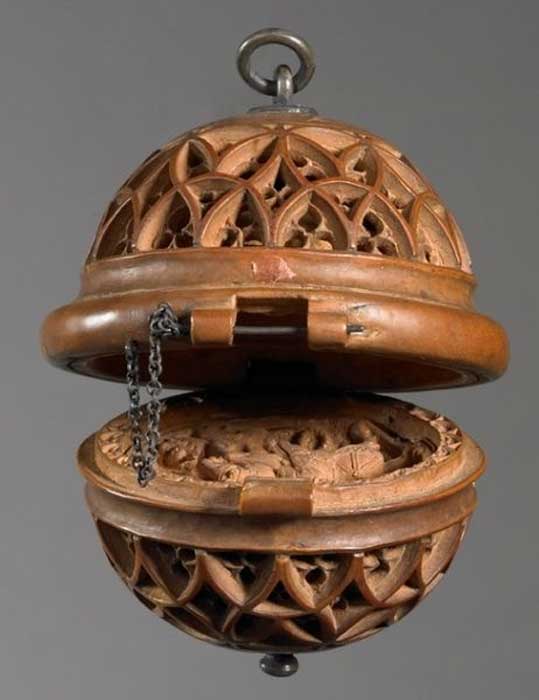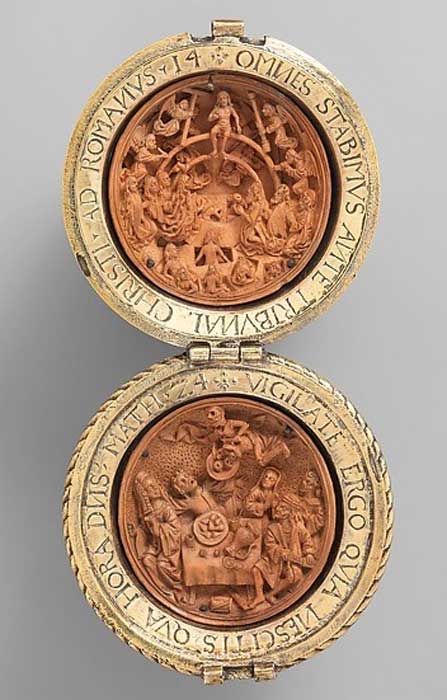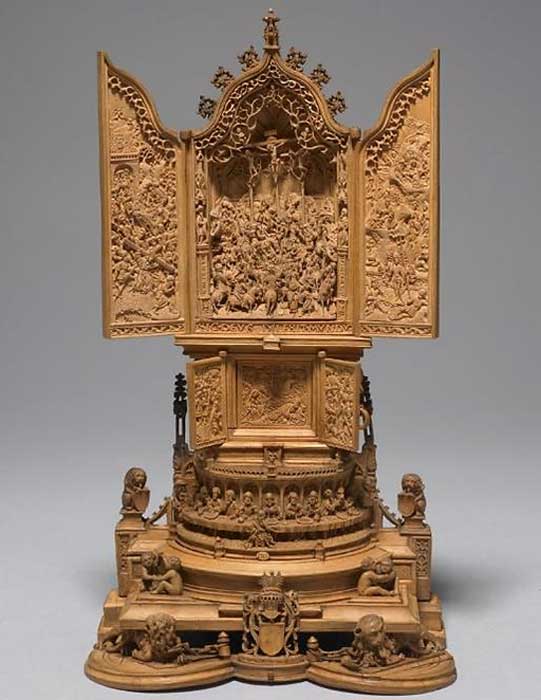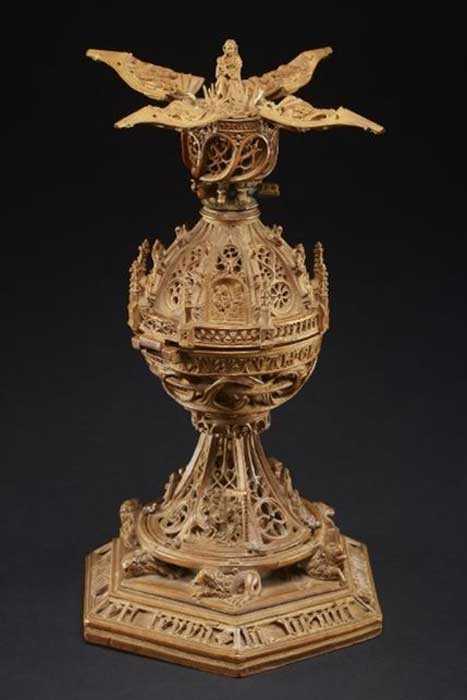
How Were They Made? Unlocking the 500-Year-Old Secret to Gothic Miniature Boxwood Carvings
A mystery that lasted for nearly five centuries was finally solved with the assistance of modern technology. The magnificent 16th century miniature boxwood carvings that had been puzzling viewers and experts alike with their depictions of heaven, hell, and life on Earth, sculpted in incredible detail, were one of art history’s greatest mysteries…but not anymore.
An Introduction to the Magnificent Gothic Boxwood Carvings
If you’re into religious art and its evolution throughout the centuries, then these small carved boxwood miniature sculptures which you can literally enclose inside your palm, are definitely going to impress you. Their iconography gets inspiration from biblical scenes (with extensive depictions of the Crucifixion). There are clear influences from contemporary literature as well. The objects' tense and unsuitable impact, being both tiny and extensive simultaneously, are especially convenient for depictions of Heaven and Hell. It is thought that the entire body of work was created during a relatively short period of time, between 1500 and 1530, somewhere in Flanders or the Netherlands. This makes perfect sense if one takes into account how during the same period of time, there was an impressive rise of a new merchant social class in Europe that created a market demand for high-quality portable religious carvings.

Rosary bead with carvings of the Vision of St Hubert and St George and the Dragon, Boxwood, Sculpture, Miniature. (Fair Use)
However, art historians suggest that these boxwood carvings were intended as luxury items and status symbols exclusively made for members of the European elite. In corroboration of this, Henry VIII of England and his first wife Catherine of Aragon, as well as the Holy Roman Emperor Charles VI and Albert V of Bavaria, are known to have owned such pieces. However, soon the Reformation began and a lot of church-related accessories went out of fashion, including the miniature boxwood pieces. An incredible art and its creator(s) would be lost for centuries.

A boxwood and silver rosary bead juxtaposes images of life and death. The boxwood bead opens to reveal carvings of Death appearing unannounced at a meal beneath an image of the Last Judgment in the upper hemisphere. The Latin inscription reads, "Stay awake, for you do now know at which house your Lord will come" (Matthew 24:42). Metropolitan Museum of Art. (Public Domain)
Boxwood Carvings, A Unique Art Form with Incomparable Design
With less than 140 surviving examples around the world today, these gorgeous boxwood carvings were puzzling historians and other experts for nearly five centuries. The mystery surrounding the creation of these unique religious pieces had mainly to do with their incredible art and design. Apparently, they were made by boxwood - which is particularly attractive to miniature wood carvers as it has an evenly soft and tactile surface when polished. The challenge of creating such a marvelous and detailed art on an extremely tiny scale, is based on the fact that these pieces would have been extremely hard to safely hold in place during their shaping and cutting.
The level of detail and excellence implies the use of magnification, probably with the same instruments used by modern jewelers in order to assess diamonds. Highlighting the level of detail mastered, decorated art historian Eve Kahn wrote at New York Times,
“The works can be so rich that individual feathers are visible on angel wings, and dragon skins are textured with thick scales. Crumbling shacks are shown with shingles missing from their gabled roofs. Saints’ robes and soldiers’ uniforms are trimmed with nearly microscopic representations of buttons and embroidery, as well as jewelry and rosary beads."

Miniature altar-piece; boxwood; upper section is a triptych with carvings of ogee arches, Crucifixion in the center, and numerous figures. Left wing: Bearing of the Cross with Sacrifice of Isaac in distance; right: Resurrection, with Entombment and other scenes in background; second stage is a smaller triptych with Agony in the Garden and, on the leaves, the Betrayal; this rests on semi-circular arcade with the Last Supper; each side has a carving of a seated lion grasping a shield; rectangular base with wrestling children filling the angles; whole rests on two recumbent lions chained to posts; between them is shield with a helmet, mantlings and crest. (British Museum/CC BY NC SA 4.0)
An even more impressed and excited Alexandra Suda, a curator of European art at the Art Gallery of Ontario (AGO) in Toronto, Canada told CNN, “They're objects that defy modern comprehension. As small as they are, they represent the limitless potential for human creativity in a way that is universal."
The Boxwood Carvings Mystery is Partly Solved
The main difficulty with artifacts and objects of this extremely tiny scale is that they simply can’t be seen with the naked eye. Traditional and digital photography failed to capture the realistic level of detail but the puzzle was eventually solved with the assistance of 21st century technology. Suda co-leaded a five-year study of the secrets behind the Gothic boxwood carvings. It was an international collaboration between scientists, academics, conservators, and other experts from some of the world's most decorated institutions, such as the Metropolitan Museum of Art in New York, the Rijksmuseum in Amsterdam, and NASA's Glenn Research Center. Suda’s team scanned and analyzed thirty of the 135 surviving carvings to find out how they were made, and by whom. With the use of micro CT scanning and advanced 3D Analysis Software, scientists managed to prove triumphantly the microscopic altarpieces, rosaries, and prayer beads are each produced from a single boxwood fragment, incorporating pins smaller than a grass seed that hold the pieces together.
Despite the immense success of decoding the mystery behind the art and design of the miniatures, the puzzle is only partially solved - since the experts can only speculate about the creators of these magnificent boxwood carvings. Due to the fact that the carvings carry no sign or symbol that would reveal the identity of their creators, experts suggest that the miniatures were probably produced by between four and six different workshops somewhere between Netherlands and Flanders. With estimates that each workshop would need around four to five years to create them, this seemed the most rational explanation. However, the incredible evenness and consistency in design and construction that the scans clearly showed, indicates that there was a single master craftsman behind these masterpieces. “This is the product of one guy's vision -- probably with a few apprentices and assistants -- who was extraordinarily gifted.

Miniature tabernacle; carved in openwork boxwood with scenes from Life and Passion of Christ; pinnacle surmounted by Pelican in her piety, which is removable, thus releasing four petals into which the upper part is divided; these are depressed by a ratchet while figure of Virgin and Child rise in center. (British Museum/CC BY NC SA 4.0)
When he died, this practice ceased to exist" Suda said to CNN and continued amazed,
"I rarely use the term genius, but I would say that this person if not a genius, is certainly an exception to the norm. The thing that really connected with me was that whoever this artist was, (he) was certainly inviting their original viewer to consider the possibility of it all, and he was quite successful because we're still thinking about that today."
"Small Wonders: Gothic Boxwood Miniatures" was an exhibition at the Art Gallery of Ontario in Toronto, Canada until Jan. 22, 2017. The exhibition will travel to the Met Cloisters and the Rijksmuseum during 2017.

A boxwood carving in the form of a rosary bead or prayer-nut. On the outside of the doors, the Virgin in the Temple (left), Marriage of the Virgin (right); inside the same doors, Moses and the Brazen Serpent (left) and the Deposition (right). Inside the upper half of the nut, the Crucifixion. The lower half of the prayer-nut is shut with one hinged flap which is carved on both sides: on the front, The Annunciation with the words spoken by the Virgin and by Gabriel within the scene as scrolls; on the other side, The Nativity, with smaller scenes of the Circumcision, Presentation in the Temple, and Christ among the doctors. Inside the lower half of the prayer-nut, is the Bearing of the Cross. On the outside of both halves, Gothic tracery and flower-heads. (British Museum/CC BY NC SA 4.0)
Top Image: A miniature boxwood carving in the form of a rosary bead or prayer-nut. The upper half depicts St Hubert adoring the stag; trees and huntsmen in background; lower half: enthronement of St Hubert following consecration by Pope Sergius [?]. Source: British Museum/CC BY NC SA 4.0
References
The Gothic Boxwood Miniatures
Alleyne, A. (2016) ‘500-Year-Old Secrets of Boxwood Miniatures Unlocked’ http://edition.cnn.com/2016/12/09/arts/mystery-of-the-boxwood-miniatures/
Art Gallery of Ontario (2016) ‘A wedding gift fit for a king’ http://artmatters.ca/wp/2016/11/a-wedding-gift-fit-for-a-king/
Art Gallery of Ontario (2016) ‘Small Wonders: Gothic Boxwood Miniatures’ http://www.ago.net/small-wonders-gothic-boxwood-miniatures
CODART (2013) ‘Curator's Project: Investigating Miniature Boxwood Carving at the Art Gallery of Ontario in Toronto’ http://ezine.codart.nl/17/issue/45/artikel/investigating-miniature-boxwood-carving-at-the-art-gallery-of-ontario-in-toronto/?id=119#%21/page/1















